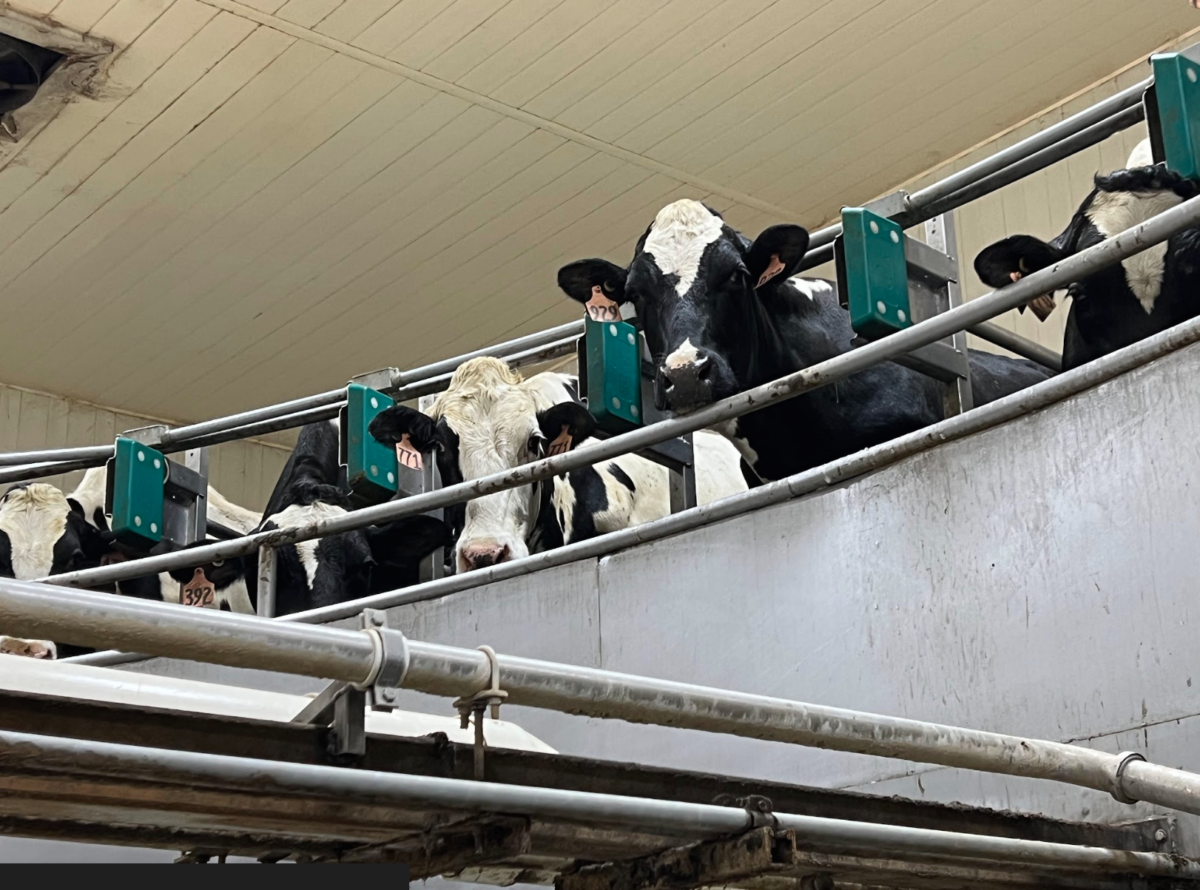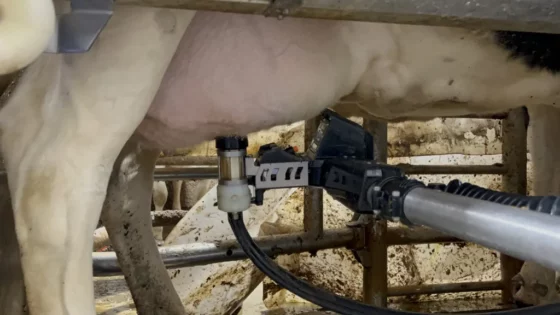Dairy producers see improved efficiency, cheaper labor, and calmer cows. The key question: Does the price tag of high-tech work for producers?

Chad Kieffer, a third-generation farmer from Utica, Minnesota, has five milkers for his herd of 350 cows.
The milkers are squat, patient, persistent workers. They hum around the mooing cows. They are robots.
In an increasingly automated world, the dairy industry is keeping up. According to Michigan State University, robotic milkers were first introduced in the United States in 2000. Now, according to Hoard’s Dairyman magazine, over 35,000 robotic milking units can be found around the world, with thousands in the US.
“It’s always changing. It’s like your iPhone getting changed every six months. There’s lots of technology that’s getting researched every day,” said Dana Allen, a fourth-generation dairy farmer from Eyota, Minnesota.
Dairy technology has transformed the industry.
Decades ago, dairy producers milked by hand. Then came buckets, pipelines, parlors, and then parlors with automatic unit removal, rotary parlors, and robots, according to Douglas Reinemann, Ph.D., a researcher at the University of Wisconsin-Madison.
Automation started in Europe. Company DeLaval started using an automated robot system at a farm in Sweden in 1997. Another maker is Lely, based in the Netherlands.
By 2000, automation came to the US. The results are significant, farmers and researchers say. Cows feel less stress, farmers are able to be more efficient and they gain time. They also save money on labor.
Now there are 500 to 1,000 U.S. operations using the milking robots, said Reinemann.
The automation is not perfect. Startup costs challenge smaller producers. As with most machinery, there also is the need for maintenance.

The robot automatically sucks the teats of the cow. (Photo by Ethan Humble, for Investigate Midwest)
Farmers gain time to work
Automated milking systems (AMS) give farmers time to focus on other work, and typically more time on skilled duties. This saves labor, Reinemann said. He also noted that AMS helps farmers ergonomically as they avoid repetitive physical tasks.
Farmers who use AMS appreciate the labor savings.
“The farmers have more time to clean up the farm, work on the crops, and other chores. It may even allow a farmer to attend their kid’s sporting events and in turn, improve their mental health,” said Mariah Busta, executive director of the Iowa State Dairy Association.
But the rate of change is up to the farmer.
“The degree to which a farmer adapts to technology and the speed at which they do it is open for their comfort level,” Allen said. “There is a tremendous amount of technology in agriculture, and I think that’s something the general public doesn’t understand.”
Robots leave cows calmer
Robots, like Kieffer’s, milk cows without the physical presence of a human being, using a robotic arm with the aid of either 3D cameras or laser beams to locate a cow’s teats.
According to the Animal Agriculture Alliance, a nonprofit focused on sustainable ag, the total time needed to milk one cow takes an average of seven minutes with a robot.
Since installing robots, Kieffer has reduced his number of full-time dairy employees from six to three.
“The robot is doing the milking for you, so the cost of the robots has to be offset by labor savings,” he said. The robots can cost more than $200,000 each.
The farmers also said the cows’ comfort is a critical benefit. Reinemann said cows can associate humans with negative interactions, such as a veterinarian checkup or being moved to and from different buildings.
“You’re allowing a cow to do what she wants when she wants. You’re not forcing her somewhere, and she can go get milked,” Kieffer said.
Cows voluntarily can go to the area indoors to be milked, farmers said. The robot system sorts cows that need to be milked based on how much time has elapsed in between milkings. Ear tags assist with sorting.
In Deer Park, Wisconsin, Kristin Quist of Minglewood Dairy keeps about 500 of her herd of 1,200 cows in a robot milking facility. She uses a system that guides the animals through the barn.
“The cow walks through a gate determining if it’s time for them to be milked after reading a tag in her ear,” she said. “If it’s time to be milked, she goes into the robot. If it isn’t, she’s sent to be fed in a different direction.”
Quist compares her newer robot facility to her milking parlor.
“The cows in the robot facility are a lot more laid back,” she said. “In the parlor facility, they are more likely to get up expecting to get milked.”
Regardless of the production method, farmers are producing more milk, primarily because of improved genetics and improved nutrition, researchers said.
Reinemann said research has shown using robots allows cows to remain in the herd longer, which can mean they produce milk longer.
“We won’t be getting any additional land or resources in the coming future, so we need to be efficient with what we have,” Busta said. “Technology is absolutely crucial in helping us continue to be efficient about producing milk in a sustainable way.”

A view of the inner structure of the rotary shows how it supports 50 cows at Gar-Lin Dairy in Eyota, Minnesota. (Photo by Ethan Humble/for Investigate Midwest)
Other farmers opt for rotating platform systems
Farmers seeking an upgrade have other options beyond milking robots.
Rotary milking parlors allow cows to step onto a circulating platform before farmers attach milking units. The system constantly moves cows on and off the platform.
Allen milks her herd of about 1,750 cows on her farm, Gar-Lin Dairy, using a platform. Gar-Lin’s rotary allows 50 cows to step onto the platform at a time.
“Before, we were milking 750 to 800 cows in about seven hours. Now we can milk 1,750 in the same amount of time,” she said.
Allen said that she initially feared the cows would be difficult to get onto the carousel-like platform, but she quickly learned the greater issue would be getting them off.
“There’s not a lot of commotion,” she said. “They actually like riding around on the rotary.”
In deciding what type of system a farmer should pursue, a farm of 1,500 to 3,000 cows likely warrants a rotary system, while a herd of 200-300 cows may be better suited for robots, said Marcia Endres, Ph.D., a professor of animal science at the University of Minnesota. With larger herds, a rotary system is more efficient because up to 50 cows can be loaded at once, though it does still require human intervention to get the cows on the platform.
One benefit of technology is more milk. In 1925, the average Iowa cow was giving 4,000 pounds of milk each year, while today’s cow gives 28,000 pounds annually, according to the state dairy association.
Some farmers are weighing the pros and cons of the technology.
Among them is Nick Seitzer, a recent University of Minnesota grad and dairy farmer from St. Peter, Minnesota. He’s thinking about adding a robot to milk his 65 cows. He forecasts about a 10% increase in production if he installs a robot in a free-stall barn.
“The robot would be huge,” Seitzer said. “Fewer people want to do what we’re doing, so it would be nice to have robots that are always there doing the job.”
But the initial cost is high. Seitzer estimates one robot would cost about $250,000, not including the physical infrastructure (such as a potential barn expansion, milk house or other needs) to use it.

A heads-up display monitors the milking progress of the cow compared to its expected yield. (Photo by Ethan Humble, for Investigate Midwest)
On his Utica, Minnesota, farm, Kieffer saw robots as a smart investment. Kieffer typically spends one hour a day doing maintenance, he said.
“Your debt per cow or debt per stall becomes rather large up front, but what I tell people is you’re basically prepaying your labor for seven or eight years,” he said. “It ends up being less than a traditional herd of cows being milked in a parlor.”
With dairy technology rapidly changing, Seitzer has been feeling pressure for his operation to adapt.
“If we don’t, we may not be doing it much longer,” he said.
Dr. Lindsey Borst, a veterinarian who milks 230 cows alongside her family in Rochester, Minnesota, feels differently. Borst has been looking at robots for five to six years.
“I wouldn’t say we’re falling behind. Robots are still fairly new, and they’re not super common yet,” she said. “Sometimes it’s also good to wait because technology is changing so quickly, too.”
Robots are not the right choice for all farmers, Kieffer, the farmer, and Endres, the University of Minnesota professor, said.
“Don’t put robots in because you don’t like cows. You also have to be mechanically inclined to do preventative maintenance on the robots,” Kieffer said.
Reinemann, the UW professor since 1990 and director of the UW Milking Research and Instruction lab, grew up in the dairyland of Wisconsin.
“For me as a young person, milking cows was so ordinary; there was absolutely nothing interesting about it,” he said. “I started my career in milking technology, and it’s been amazing. The shifts in the technology and how dairy farms are managed, it’s been a lot of change.”
Investigate Midwest is an independent, nonprofit newsroom. Our mission is to serve the public interest by exposing dangerous and costly practices of influential agricultural corporations and institutions through in-depth and data-driven investigative journalism. Visit us online at www.investigatemidwest.org
Technology really helps us a lot, especially in agriculture and industry. In the past, my mother had to get up very early every day to milk the cow and moreover, this stage was also very tiring. Fortunately, technology now supports that work.